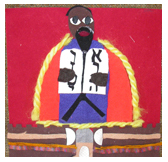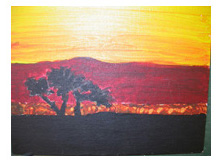Making the Most of the End of the Year Art Closet
Laurie Bellet
It’s the end of the year. Classrooms get cleaned out and the art closet becomes the repository of all the leftover and unused art supplies that have collected in the cabinets and on the shelves. The easiest thing to do is to close the closet door and plan to “deal with it” when school reopens. Reluctant though you may be to tackle the mounting chaos sooner, rather than later, a few simple steps now can save you money and waste later.
No matter how carefully and faithfully paintbrushes have been washed, they can still hold onto a good deal of paint. The bristles on brushes that have eluded washing do harden. And end of year soaking and washing in Murphy’s Oil Soap can easily rejuvenate and fully clean your brushes. For brush bristles that seem to have solidified, sit them for a few days in undiluted Murphy’s. This process will likely save every brush you have. You can also wash your scissors this way because, doubtless they have become glue encrusted.
Glue bottles have a way of sealing themselves shut. Again, the Murphy’s Oil Soap (or Dawn Detergent) will come to your rescue. Unscrew the caps and soak them for a day or two. You may need to use pliers on the stubborn caps or even soak the entire bottle until the cap loosens. Clean the old glue off the caps and be sure to wash the neck of each bottle before replacing the caps. Check every glue stick as well, wash these in the same way and close them tightly. (Make a note to yourself that small glue sticks dry out more rapidly than do large ones)
Paint bottle caps and necks should also be washed before they are securely closed. If you have many bottles of the same brand/color of paint, consolidate these so you have a clear picture of your paint stocks. Check your watercolor palettes to determine if they are still usable and just need cleaning or if they require discarding.
Markers needn’t be left uncapped to dry out. Caps that are not “clicked” shut will also ruin your markers. Take the time to try each marker. Click their caps shut so they will be ready to go when students return. Save the dried markers to make into watercolor paints and mezzuzot, as I described in a recent column.
Construction paper should be stored out of exposure to sunlight. You may notice that some of your paper has faded edges. Since few teachers will readily use this paper, take the time to use the paper cutter to remove the faded edges. This will keep the paper attractive to teachers and students and reduce your paper expenditures in the Fall.
The most challenging task of art closet clean-up is deciding what to keep and what to discard. There are so many odds and ends to be found and tossing any others away seems like such a waste! This is your opportunity to evaluate your past year’s art program and assess your art programming goals and dreams for the coming year.
To make the best use of your remaining supplies, and to determine your ordering needs, you should clarify whether your art program is craft based, art based, or a structured hybrid of both, with the understanding that the “right” answer is the programming strategy that best suits your curriculum structure and your learning objectives.
A craft-based program is product driven. You have defined supplies with a step by step instruction plan. Although students may individualize their work with personal color choices, their end products “converge,” that is they all do result in the same end product. Falling under this category might be havdalah sets, hanukkiyot and the like. A craft-based program requires specialized materials, enough for each student. When you have a predetermined sequence for these projects, you do want to keep the leftovers from the previous year, to boost your next year’s stock. You can plan your craft sequence and purchasing from published sources (The Reluctant Artist is still available) and teachers can follow the printed instructions.
An art-based program is process driven. Students receive their learning and instructed to bring the learning to life using a variety of basic art supplies (paints, drawing tools, collage materials). Although the students begin from the same learning point and select from the same materials, through the working process, their products “diverge.” That is to say that everyone’s creative experiences and art pieces differ. With an art based program, students are encouraged to document their creative process and their art as these relate to their learning. For an art program, you need a stock of paints and brushes, drawing tools, glue, scissors, fabrics and yarns, papers and modeling compounds. Odds and ends of materials from the previous year can be stored in clearly marked bins or, if there are not many, you can put them in what my students call the “This and That” box. With an art-based program you do not need a class set of any sort of materials or tools, because each student selects the materials he or she needs from standard art supplies and little to nothing goes to waste. Art processes result in uniquely meaningful learning and do require that teachers study in order to acquire a strong knowledge base and to develop supportive facilitation skills. (E-mail me at lbellet@ohds.org for potential lesson plans and resources).
When you hybridize your program, you include predictable craft projects within your overarching art program. In this scenario, you keep the specialized materials you need for the craft projects and maintain your basic art supplies for frequent use by your student artists. Although the program at Oakland Hebrew Day School is heavily art-driven, I know that I need silk squares for the 1st grade hallah covers for Haggigat ha-Siddur, cloth strips for each 2nd grade artist to make a personalized Torah wimpel for Haggigat ha-Humash and specific supplies for the 5th grade edot program.



